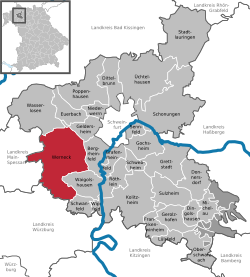History
The first written record of Werneck is dated 10 August 1223, as a fief granted by Bodo of Ravensburg, confirmed by the Pope on 9 April 1223. Between 1224 and 1250, possession of the fief was shared between first the Teutonic Knights and later Conrad of Reichenberg and Conrad of Schmiedefeld, until it finally passed to the Bishopric of Würzburg. A fort located there was sacked in the Peasants' War in 1525 and then seized and burnt down by Albert Alcibiades, Margrave of Brandenburg-Kulmbach in 1553. It was rebuilt in 1601 under Prince-Bishop Julius Echter von Mespelbrunn, but was again destroyed by fire in 1723 and merely patched up in 1724.
The current baroque palace, Schloss Werneck, designed by Balthasar Neumann, was built in 1733–45 by Prince Bishop Friedrich Karl von Schönborn. For half a century it was, with Veitshöchheim, a summer residence of the Bishops of Würzburg. On 28 November 1802, the last Prince-Bishop of Würzburg, Georg Karl von Fechenbach, released his vassals there from their oaths of service and recommended them to the new regional overlord, Maximilian, Prince-Elector of Bavaria.
In 1803, following secularisation, Werneck became a Bavarian possession. In 1805 it was transferred to Ferdinand III, Grand Duke of Tuscany as part of the formation of the Grand Duchy of Würzburg. The Treaty of Paris in 1814 returned it to Bavaria.
Beginning in 1853, the palace was converted into a hospital for the mentally ill, the Unterfränkische Landes-Irrenanstalt (Lower Franconian State Asylum), which opened on 1 October 1855. Its first director was Bernhard von Gudden (who later wrote the clinical assessment which justified deposing King Ludwig II and who drowned with him in Lake Starnberg). The hospital is thus one of the oldest psychiatric institutions in Germany. In 1940, the approximately 800 patients were murdered on the orders of Otto Hellmuth, Gauleiter of Mainfranken, as part of the Nazi elimination of mentally ill and handicapped people, Action T4.
Economy
Although the villages within the municipality of Werneck are still agricultural in character, there have been several decades of economic dependency on industries in Schweinfurt, to which many residents commute. In 1998, the municipality had 8 agricultural and forestry jobs, 595 production jobs and 228 trade and transport jobs subject to social insurance; 1,555 were employed there in other fields. A total of 3,559 residents held jobs subject to social insurance. There were 2 businesses engaged in the harvesting of natural resources (such as mining and quarrying) and 10 in construction. In addition in 1999 there were 195 agricultural businesses, utilising 6,382 km², of which 5,681 km² was cropland and 672 km² permanently planted (pasturage, orchards, etc.)
Infrastructure
Transport
Werneck is located at the Werneck Autobahn junction, where the A 7 and A 70 merge; in addition, the A 71 has passed close by since its Werntal connection to the A 70 opened in November 2005. Bundesstraßen B 19, B 26 and B 26a pass through Werneck. On 16 December 2007 the Werneck bypass on the B 19 was opened.
There is a railway station on the Schweinfurt - Würzburg line in the centre of Eßleben and another very close to Werneck proper, on its border with Waigolshausen. The Werntalbahn (Wern Valley Railway), now used mainly for goods traffic, runs through the municipality.
Health care
Today the psychiatric clinic (Krankenhaus für Psychiatrie, Psychotherapie und Psychosomatische Medizin Schloss Werneck) is operated by the Administrative Region of Lower Franconia and serves northeast Lower Franconia (Schweinfurt, Hassberge, Rhön-Grabfeld, Bad Kissingen and Kitzingen, with a total population of 500,000) with a modern 290-bed building, while the palace houses the Lower Franconia orthopaedic clinic (Orthopädische Klinik Schloss Werneck), one of the largest such facilities in Germany, with 153 beds. There are also care homes for psychiatric and senile dementia patients (Albert-Schweitzer-Haus, Haus Erthal and Haus Schönborn) on the grounds. Together these facilities are the largest source of employment in Werneck.
This page is based on this
Wikipedia article Text is available under the
CC BY-SA 4.0 license; additional terms may apply.
Images, videos and audio are available under their respective licenses.







